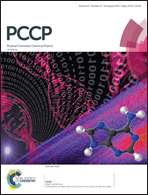Molecular clustering and percolation characteristics near the glass transition in aqueous trehalose and choline dihydrogen phosphate solutions†
Abstract
Spatial and temporal characteristics of molecular structure in ternary solutions of trehalose and choline dihydrogen phosphate (CDHP) are studied using molecular dynamics simulations at 300 K for a range of solute concentrations with a 2 : 1 stoichiometric ratio of trehalose to CDHP. For a given molecular configuration, water molecules are classified as interior (only neighboring other water molecules) or interfacial (at least one solute neighbor). As a tagged water molecule diffuses, it dynamically exchanges between interior and interfacial type as its local environment changes, with differences in hydrogen-bond strength between different molecular species creating a persistent preference for interfacial water. At high solute concentrations, interfacial and interior water have similar diffusivity, which allows for water to collectively act as a plasticizer. The percolation threshold for water, defined as the maximum solute concentration at which there still exists a water cluster that spans the simulation box, was found to be slightly under the liquid–glass transition, estimated to be near 84.5% solute concentration based on the onset of a volume hysteresis effect, which was not previously studied in the computational literature. The systems were observed to be highly inhomogeneous, with interlaced percolating networks of water and solute coexisting at intermediate concentrations. The density of interior water was found to decrease with increasing solute concentration, creating low-density regions within the matrix.



 Please wait while we load your content...
Please wait while we load your content...